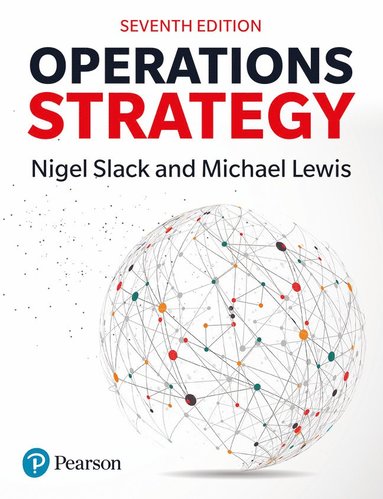
- Format
- Häftad (Paperback)
- Språk
- Engelska
- Antal sidor
- 504
- Utgivningsdatum
- 2023-10-27
- Upplaga
- 7
- Förlag
- Pearson
- Medarbetare
- Lewis, Mike
- Dimensioner
- 27 x 241 x 188 mm
- Vikt
- Antal komponenter
- 1
- ISBN
- 9781292459271
- 962 g
Operations Strategy
- Skickas från oss inom 5-8 vardagar.
- Fri frakt över 249 kr för privatkunder i Sverige.
Passar bra ihop
De som köpt den här boken har ofta också köpt Slow Productivity av Cal Newport (häftad).
Köp båda 2 för 1050 krKundrecensioner
Fler böcker av Nigel Slack
-
Essentials of Operations Management
Nigel Slack
-
Operations Management
Nigel Slack
-
Operations and Process Management
Nigel Slack
-
New CFOs
Liz Mellon, David C Nagel, Robert Lippert, Nigel Slack
Övrig information
Nigel Slack is an Emeritus Professor of Operations Management and Strategy at Warwick Business School, Honorary Professor at Bath and Birmingham Universities, and Honorary Fellow of the European Operations Management Association. Michael Lewis is a Professor of Operations and Supply Management at Bath School of Management.
Innehållsförteckning
Preface Authors' acknowledgements Chapter 1 What is operations strategy? Introduction 1.1 Why is operations excellence fundamental to strategic success? 1.2 What is operations strategy and how is it different from operations management? 1.3 How should operations strategy reflect overall strategy (top-down)? 1.4 How do the requirements of the market influence operations strategy (outside-in)? 1.5 How can operations strategy learn from operational experience (bottom-up)? 1.6 How can the intrinsic capabilities of an operations resources influence operations strategy (inside-out)? Summary answers to key questions Further reading Notes on the chapter Chapter 2 The context, content and process of operations strategy Introduction 2.1 What is the difference between the context, content and the process of operations strategy? 2.2 What is the context of operations strategy? 2.3 What is the content of operations strategy? 2.4 What is the process of operations strategy? Summary answers to key questions Further reading Notes on the chapter Chapter 3 Operations performance Introduction 3.1 What is meant by operations performance? 3.2 How is operations performance judged at a societal level? 3.3 How is operations performance judged at a strategic level? 3.4 How is operations performance judged at an operational level? 3.5 Does the relative importance of performance objectives vary over time? 3.6 Do operations performance objectives trade-off against each other? 3.7 What are the advantages and disadvantages of focused operations? Summary answers to key questions Further reading Notes on the chapter Chapter 4 Responsible operations strategy Introduction 4.1 What is responsible operations strategy? 4.2 How does the environmental dimension of responsibility affect operations strategy? 4.3 How does the social dimension of responsibility affect operations strategy? 4.4 How does the economic dimension of responsibility affect operations strategy? 4.5 How does the stakeholder dimension of responsibility affect operations strategy? 4.6 How does the voluntariness dimension of responsibility affect operations strategy? Summary answers to key questions Further reading Notes on the chapter Chapter 5 Capacity strategy Introduction 5.1 What is capacity strategy? 5.2 How much capacity should an operation have? 5.3 How many separate sites should an operation have? 5.4 What issues are important when changing capacity levels? 5.5 What tasks should be allocated to sites? 5.6 Where should capacity be located? Summary answers to key questions Further reading Notes on the chapter Chapter 6 Purchasing and supply strategy Introduction 6.1 What is purchasing and supply strategy? 6.2 What should we do and what should we buy? 6.3 How we buy: what is the role of contracts and/or relationships? 6.4 How do we manage supply dynamics? 6.5 How do we manage supply networks over time? 6.6 How do we manage supply chain risks? Summary answers to key questions Further reading Notes on the chapter Chapter 7 Process technology strategy Introduction 7.1 What is process technology strategy and why is it becoming more important? 7.2 How can process technology be characterised? 7.3 How do market volume and variety influence process technology? 7.4 How can process technology be evaluated strategically? Summary answers to key questions Further reading Notes on the chapter Chapter 8 Improvement strategy Introduction 8.1 What are the different approaches to improvement? 8.2 How do the needs of the market direct the ongoing development of operations processes? 8.3 How can the ongoing management and control of operations be harnessed to develop their capabilities? 8.4 What can operations do to deploy their capabilities into the market? Summary answers to key questions Further reading Notes on the chapter Chapter 9 Product and service development strategy Introduction 9.1 What is the relationship between innovation
Du kanske gillar
-
48 Laws of Power
R Greene
HäftadTransformed
Marty Cagan
InbundenFrågor & svar


